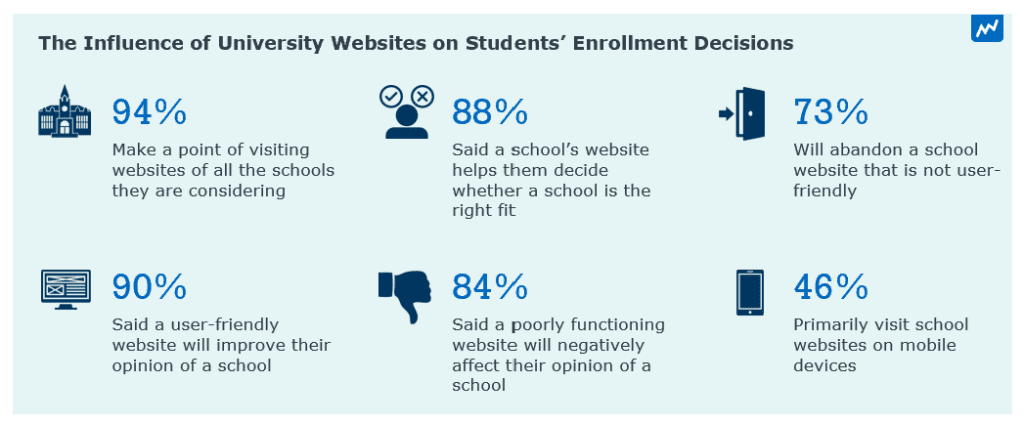3 ways to make your website stand out to graduate prospects
As a former lead of graduate recruitment marketing at a large public university, I’ve been grappling with the ever-evolving, increasingly hard-to-pin-down nature of prospective student search behavior for years. Today’s graduate prospects are pragmatic, often stealth shoppers, with little time to waste on extraneous information. Even though they consider your website the #1 most helpful resource in their college search, a growing desire for privacy—paired with an expectation of personalized content—makes it harder than ever to reach and engage this group early in their search.
These challenges create frustration (with a capital “F”) among enrollment and marketing leaders looking for ways to improve university websites for graduate student recruitment. To make your job a little easier, we surveyed 6,000 prospective and current graduate students to uncover their preferences regarding communication, search behavior, and the .edu experience. Our goal? To help you drive visibility, engage website visitors, and ultimately convert them into new students.
The 3 Fs for engaging grad prospects on your university website
In this blog, I’ll share the 3 “Fs” your .edu needs to ensure your web experience meets prospective students’ expectations. Read on to discover how to make your site functional, findable, and focused.
Your website must be functional
Having a functional, user-friendly site may sound obvious, but college and university websites are notoriously complex. Prospective students form lasting impressions about your institution based on your website, making functionality a cornerstone of your web strategy. In fact, 94% of prospective graduate students surveyed said they visit the websites of every school they are considering. Even more telling, 88% said a school’s website plays a key role in determining whether an institution or program is the right fit—a 10-percentage-point increase since 2023—underscoring the growing importance of your .edu experience.
Your site must be intuitive and easily searchable, with clear navigation tools and CTAs strategically placed to maximize engagement. If your site isn’t user-friendly, you risk losing 73% of your prospects who will leave if they encounter friction. Additionally, 84% of respondents indicated that a poorly functioning website negatively affects their perception of a school.

Finally, prioritize a mobile-first web experience to meet prospective students where they are. With 46% of graduate prospects primarily visiting your school’s site on mobile devices and given that Google switched to mobile-first crawling and indexing in 2016, delivering a mobile-first experience is no longer optional. It’s a baseline expectation if you want to engage and convert right-fit prospects.
How Lewis and Clark College Turned Their .edu Into an Enrollment Engine
Make sure your enrollment-critical pages are findable
With the rise of stealth shopping, data privacy concerns, the impact of AI, and Google’s zero-click search environment, your SEO strategy must be sharper. According to a recent survey of graduate, online, and professional program leaders, stealth shoppers now make up about 80% of your prospect pool. What’s more, only 50% of prospective grad and adult learners will share their personal information with a school after conducting their own research. This makes it critical to strategically optimize your site’s content, keywords, and technical elements to improve visibility, so prospects can find you exactly when they’re ready to engage. But achieving this is often easier said than done
-
80%
of graduate, online, and professional program applicants engage in stealth shopping
SEO, at its core, is your organic traffic strategy. Understanding what prospective graduate students look for in a university website can help you create an optimal search-to-site experience—a click path fueled by content that aligns with search intent. To rank in Google search results and drive organic traffic, your content must be relevant, authoritative, student-centric, and data-informed.
Adding to the complexity, SEO is evolving in response to the proliferation of AI and Google’s zero-click search environment. Check out the box below for key insights from EAB expert, Adnan Sosic. He shares actionable tips on how enrollment leaders and digital marketing teams should adjust their strategies to address these changes.
SEO in the age of AI search
Methodology Shift
Search engines are transitioning from traditional algorithms to large language models (LLMs) and generative AI, which can understand and generate human-like text. This allows for more complex query interpretation and nuanced answers.
User Experience Change
Search results are evolving from lists of links to direct AI-generated answers, potentially reducing visibility for individual websites.
User Behavior Evolution
Users are likely to move away from simple, keyword-based queries to more complex, conversational questions, with the expectation that AI will understand and respond accurately.
To address these challenges, EEAT (Experience, Expertise, Authoritativeness, and Trustworthiness) becomes crucial:
- High-quality, EEAT-compliant content is more likely to be favored by AI algorithms.
- EEAT principles help search engines identify trustworthy sources, minimizing the risk of misinformation in AI-generated responses.
- Content that demonstrates deep expertise and first-hand experience is better positioned to address the increasingly nuanced queries from users.
- Strong EEAT content has a higher likelihood of being cited in AI-generated overviews, potentially increasing click-through rates.
Keep your content strategy focused on information users want most
Nearly half—48%—of adult learners and adult degree completers are specifically searching for admissions, cost, and financial aid or scholarship information on your program pages. Given that your prospects tend to be pragmatic and pressed for time, your content strategy should focus on delivering what they need most and avoid unnecessary details or fluff. For example, ensure content is clear and concise on your most enrollment-critical pages, and that these pages flow naturally so users can easily find the information they need.
Learn 3 Best Practices to Maximize the Enrollment Impact of your Website
In addition, your primary audience—Gen Z and millennial prospects—have specific expectations for how content should be presented if you want them to stay on your site and take action. Both generations begin their user journey on search engines, making your content and SEO strategies essential for success. Both Gen Z and millennials alike are turned off by inauthentic content and unintuitive web experiences. They expect fast, relevant, and authentic information, that not only answers their questions but also demonstrates what they’ll gain from attending your school or program.

Turn interest into action
If your institution is like many, your .edu is not yet delivering the web experience your prospects expect. The good news is you don’t need a full site overhaul to see significant improvements. EAB’s Digital Agency team can help transform your .edu from a content warehouse to a marketing engine, turning your website into your most powerful marketing tool for guiding prospects through the enrollment funnel.
How does your college site compare to the competition?
Looking to position your institution for success in the competitive higher education landscape? EAB offers a variety of web services, starting with an SEO audit to help measure your site’s effectiveness in engaging prospective students and parents.

Stealth shoppers are everywhere. Here’s how to reach them.

Your future grad and adult students’ new search behaviors

More Blogs

Is your email marketing strategy outdated? Here’s what to do instead.

Marketing to today's adult learner can be cheaper than you think with these 3 social media tactics

Struggling to engage busy adult learners? Start by auditing your recruitment emails.
Great to see you today! What can I do for you?